Location: Snowy
Range, Medicine Bow National Forest, Wyoming
Access: The
Lewis Lake TH is just off Hwy 130 about 11 miles west of Centennial.
Trail: Moderate
with some steep spots. 2 miles to Shelf Lakes from the Lewis Lake TH
Trailhead: NAD83
z13 391715e 4579393n Elev: 10,770'
Maps: 1:24K
USGS quads: Sand Lake and Medicine
Bow Peak
Fees: Parking
at the Lewis Lake TH costs $5, but there are nearby free alternatives
Dogs: Voice
control
Webcam: Arlington
Interchange, 30 miles north
Weather: Snow
conditions NWS
Forecast
August 2, 2006 Wednesday
(I should be at work, but Iím not.)
I load the car with
my backpack and boots and around 9:00 open the back door so Frank and Makenzie,
both pointers, can scramble and lurch into the backseat for the 1.5-hour
drive from Cheyenne to the Snowy Range. It's cool outside, but that serves
to clear the sky of haze, and the blue that shines down is the perfect
kind of blue that makes you want to spend all day outside. I intend to.
In Laramie, I stop off at Subway to buy a sandwich at around 10 AM and
take it with me to the car where I drive southwest out of town on Highway
130 towards Centennial. Puffy white clouds accent the blue sky, but it
is cool enough outside that I am optimistic that they will not develop
into thunderstorms. Spend enough time in the Rockies, and you're always
watching for thunderclouds. Over the plains we drive, past herds of cattle
behind whimpy-looking barbed wire fences, sagging with age and rust. Enormous
rolling hills covered in browning grass stretch off to either side. The
road leads through Centennial, a tiny town with no stop sign that I have
ever seen. There are about 4 businesses in Centennial, all catering to
campers. I do not stop, but am forced to do so anyway just a mile or so
further on as the highway department has chosen this week for road resurfacing.
I pull up to the long line of cars and kill the ignition to wait. My luck
is amazing, and almost immediately, the pilot car appears around the bend
ahead towing a long line of campers, RV's, trucks, jeeps and SUVs. They
all pass slowly, spraying gravel, and then we are on the move again, slowly
following the pilot car. After a slow but beautiful drive through the verdant
lodgepole pine forest, past the Little Laramie River, we emerge beyond
the road work and pick up speed. I roll the windows up since it gets pretty
cool outside, and start looking for a spot to stop and eat my sandwich
that is still sitting in the front seat. The forest changes as we drive
higher in elevation, and the pines are replaced with spruce, which are
in turn replaced with ever-larger patches of alpine tundra. Makenzie begins
to pant as she senses that grand adventure is close at hand. As the road
grade levels out, I spot a pullout near a lush green meadow and stop the
car. Frank and Makenzie spill out of the backseat when I open the door,
clawing over each other with eagerness to frolic in the flower-filled meadow.
I am hardly less enthusiastic, I just hide it better. I lead the two idiot-frenzied-canines
100 meters from the road and find a sunny high spot (dry) just south of
a large spruce tree that blocks the wind (warm) and sit down to dine on
a professionally-made meatball sandwich. Very tasty. I down it in no time.
The dogs, preoccupied with obviously rapturous scents in the grass of the
meadow, don't even beg for scraps. Without much delay, I herd them back
to the car and we drive up just a little farther to where I intend to park
the car at the newly-renovated Sugarloaf Recreation Area. As I drive in,
I note a sign that demands payment for parking in the form of a self-register
day-pass. Since I intend to park here for several days, I am not sure that
a day-pass will do, and yet I am loathe to pay for 3 parking passes at
once (which would cost me $15, much more than my sandwich from Subway).
Besides, I didnít ask them to tear up the perfectly functional parking
lot that used to be here just so more people could park, picnic and have
a pleasant-smelling outhouse with brightly-painted lines on the asphalt.
In fact, when I took the survey in 2002, I specifically told the nice Forest
Service lady, "Donít change a thing." Then they went off and changed everything.
I decide to spurn the Forest Service's new fancy parking lot, which took
them 2 years to renovate, and instead cruise down the highway about 1 mile
to the Medicine Bow Overlook point. No picnic tables or outhouses here,
just a simple flat spot to park the car. Just right. From here, the imposing
east wall of the Snowy Range is just across a shallow valley. Over a thousand
feet of vertical white granite slabs line the horizon from north to south,
with rifts of snow still clinging to the deeper, colder cracks. Below the
rock, blue lakes sit like tiny puddles after a rainshower. In fact, they
are huge lakes, but dwarfed by the mountains. I hop out of the car and
pull my pack and boots from the trunk. While I am lacing my boots, two
biker chicks in the full leather getup cruise into the lot, their
Harleys gurgling in the thin mountain air. They review the scene for a
few moments and then approach me as I am strapping my tent to my pack.
They ask me where I'm going and seem incredulous to learn I'm going to
camp out for 2 nights alone in the mountains. I point out that in fact
we are a party of 3, it's just that 2 of us can't talk or rig a splint.
They are friendly ladies, and quite attractive too, so I talk with them
as long as they like while I finish rigging my pack, and end by taking
their photo for them on a teeny digital camera proffered to me by the petite
gal. With their blessings of good luck that I don't anticipate needing,
Makenzie, Frank and I start walking north, over the tundra. I harbor a
secret satisfaction that my backpacking plans could impress city dwellers,
and thank my good fortune to have escaped such an urban-slave life myself.
We have to cross the highway right away, but traffic is light and we don't
even have to wait. No cars are moving on the road, after all it is a Wednesday.
I lead our intrepid group north, detouring around large rock fields and
fishing my way through dense stands of short spruces. The Snowy Range is
ever-visible to the west, and I canít help but stop and photograph it often.
Wildflowers are rocking back and forth in the brisk breeze, and the sun
sends shafts of white light almost unimpeded the ground. I head towards
what I believe is Libby Lake and soon come upon a long slope that leads
downhill to the blue water. Makenize, eager as ever to get her feet wet,
tromps on ahead in a dull gallop that she is famous for and leaps, legs
splayed, into the cold mountain lake. After splashing around and stirring
up the mud for a ten foot swath along the shore, she emerges wet and dripping
to run up the slope and shake off the water as near to me as possible.
Obviously I had wanted to share in the experience. Frank stays well-clear
of the water, as usual. We walk along the western shore of the lake, heading
north. My next goal is to intercept the trail that leads by the Gap Lakes,
not an especially easy thing since this area around Sugarloaf Mt is pockmarked
by a dozen medium-sized lakes, all of which have significant outflow streams
any time of year. Near the north end of the lake, Makenzie trots
up with her red pack sliding off her broad, table of a back. I see that
the elastic chest strap has broken, and sit down to mend it with my leatherman
and nylon rope. After this little break, we head north again right between
Lewis and Klondyke Lake and cross several wide streams (just shallow enough
to walk through without wetting socks) and end up on the trail to Gap Lakes.
Wonderful. I survey the sky: still mostly clear. I retain my optimism and
continue up the trail. I see several hikers on the trail, and each time
I approach someone, I throw a stick off-trail for the dogs to chase so
there is no chance of the dogs pestering anybody. We reach the shore of
South Gap Lake and head north on a route through the boulder field that
completely surrounds the lake. On the far side of the lake, the mountains
rise up from the shore almost vertically, and devoid of vegetation. The
brisk breeze sends whitecap waves rushing across the water, with occasional
gusts that flatten the water and knock down the waves. The trail leads
up to the pass between the two Gap Lakes, and soon we are plodding down
the steep route towards the shore of North Gap Lake. North Gap Lake is
very large, and looks very deep. Like it's southern counterpart, the western
shore of North Gap Lake rises steeply over a thousand feet of bare granite
to the mountain top. The northeastern shore, unlike South Gap Lake, is
lined with spruces and flowers that burst forth from any spot where soil
has collected among the rocks. We hike the trail over a hill of loose boulders
and then reach a trail branch with the eastern spur leading up a steep
hill to the Shelf Lakes. We take this trail and labor up the steep grade
to the smaller and calmer lakes above. The Shelf Lakes are two narrow bodies
of water at around 11,000 ft that lie in an east-west axis. We approach
the first lake along the well-worn path from the west. To the south of
the lake, and rising right up from the water, lies Browns Peak, a barren
pile of rocks, basically, and to the north lie three tree-covered humps
that hold the lake back from simply spilling down the steep slope beyond
to Cresecent Lake. I scout around to the north of these humps and finally
come upon a clearing at the top of the hump next to the east Shelf Lake.
It is a nice spot of flat bare earth in an oval shape, completely encircled
by a dense wall of stunted spruce and fir standing about 8 feet high. A
fire pit in the clearing alerts me that others have stayed here before.
I set my gear down, and decide to stay here if the weather continues to
look good after a few hours. Since it is one of the highest points around,
it is definitely NOT a spot one would want to be in during a thunderstorm.
It is 2:45, and the afternoon is young. I snack on chocolate and water,
then liberate my fishing gear from my pack and head down to the lake. I
find a nice spot on the eastern shore where the wind is calm and begin
casting out a dry fly. After noting that nothing is rising, I wet the fly
down good and allow it to sink in the water. Frank and Makenzie lay on
the flat slabs of rock nearby, soaking in the warm sun in the chill air.
Within 15 minutes I feel a sharp tug on the line, and reel in a 15" brown
trout, the largest fish I've ever snagged in Wyoming. I grin and work to
quickly unhook the fish, whose jaw is enormous. I contemplate how long
it takes for a fish to grow to 15" in a mountain lake that is ice-free
for only about 3 months a year. Not wanting to end this old fish's life,
I let go of it as it dashes away into the deep. I fish for another hour,
occasionally moving down the shore. I catch nothing, but then fishing isn't
the main objective anymore. The main objective is to soak it in, to relax,
to breath deep that fresh and lucid mountain air and feel the sun warm
my shoulders; to feel the tickle of reflected sunlight off the water in
my eyes. Beyond the shimmering lake, the mountains west of North Gap Lake
shine brilliantly in the clear sky. Feeling drowsy, I pull in my line and
Frank, Makenzie and I take a walk east to check out what lies beyond the
trees on the edge of the lake. The slope goes up for a little ways past
more tree-covered humps, then descends down into ever-thickening forest.
The map shows that this trail eventually circles around the south shoulder
of Brownís Peak and returns travelers back to Lewis Lake, but I do not
follow it to see. I return to camp and snack again on a tasty and salty
summer sausage. I read a few pages from A Bend in the River by VS Naipauli,
then doze off in the warm sun. When I awake it is nearly 5 and the sky
is almost completely clear. I decide it is OK to camp here and set up the
tent. We three take another walk, west this time to overlook the North
Gap Lake from a bald plateau high above the lake. The light is golden and
beautiful, streaming unimpeded through thin mountain air and drawing out
the yellow in the deep green grass and trees. We walk a large loop to the
north, past placid shallow pools surrounded by reeds, and end up back at
camp an hour later. Frank is tired from all the walking, and lets me know
he wants to go to bed. I unzip the tent and he staggers in, flopping down
heavily on the puffy down sleeping bag that I brought for them. I find
if I don't bring a pad and small down bag for the dogs, they sleep on mine,
so I sleep better if they sleep better. Makenzie and I stay outside and
enjoy the deepening evening shadows, and the reddening light as the sun
sinks in the west. She follows me curiously as I scramble over rocks and
ledges to get photographs of the surrounding krumholtz jungle. A half moon
rises to the south as the sun sets, and we retreat to the tent around 8:00.
I spend some time reading before falling off to a pleasant sleep.
August 3, 2006 Thursday
(A bad day in the woods is better than a good day at the office.)
At 5AM my watch beeps
me awake and I dress quickly in the cold morning air. Ironically, I donít
typically get up until after 6 on a workday. I emerge from the tent to
a cloudless blue sky that is glowing with the first rays of sunshine. I
set up my camera on a tripod on a rock that sits high enough to see over
the wall of spruce trees around camp, and wait in the quiet stillness of
dawn. The dogs are cold, and I try to coax them into getting back in the
tent, but they won't hear of it, and instead stand shivering in the predawn
chill. I stand around until 6:20, rubbing my hands and face, for the sun
to really flood the mountains, but even then most of the light is blocked
by Brownís Peak. By quarter to 7, I put my camera away and decide to get
back in the tent and lay down to warm my extremities. So, leaving my boots
outside, I get into the tent with the dogs, who are only too happy to get
back under the down warmth, and without undressing at all, I cover myself
with the open sleeping bag and enjoy the immediate warmth. Without intending
to sleep at all, I doze off into a deep and delicious sleep that lasts
for 2 hours. Startled at the long nap, I get up and emerge from the tent
to a warm morning with a bright white sun and a blue sky. I throw some
gear in my daypack and the three of us charge off west towards North Gap
Lake, which is stunning in the morning light. Heading north from there
we intercept a trail and follow it towards Deep Lake, a secluded lake that
I've camped at before. As we are descending in elevation from the Shelf
Lakes, I notice that the trees regain their stature, casting long, deep
shadows over the verdant undergrowth. We pull off the trail about 50 meters
and I enjoy a breakfast of sugar-laden cereal and reconstituted milk while
Frank and Makenzie crunch down on some of the kibbles Makenzie hauled in.
From the shadowy undergrowth, we sit unnoticed as a girl scout troop passes
by on the trail. I thank my good luck to be off the trail when such a large
group comes tromping by. Back on the trail, we reach a junction and head
west again to Reservoir Lake, where I fish for about 30 minutes and reel
in 4 large brook trout before 3 other men show up and make it feel crowded.
We move on, back east, into the woods and a rest in the sunlight of an
open meadow. As I crunch on my peanut butter granola bar, the dogs swerve
back and forth through the grass, noses to the ground, tails not wagging
back and forth but instead arching wildly in a circular motion that describes
a figure 8. We walk north through large spruce trees to Cutthroat Lake,
but 2 men are fishing the shore nearest us so we keep going through the
woods to the west, and downhill to Meadows Lakes where the mosquitoes are
bad. I fish anyway, and catch 2 brook trout. The sky clouds over, and this
emboldens the mosquitoes to the point where I must leave the water. By
12:30 we find ourselves heading back towards camp, seeking to be close
to shelter should it decide to rain. Along the way, I stop at Crescent
Lake near the Shelf Lakes and fish for an hour, knowing that camp is but
20 minutes away. I haul in 4 brook trout, and as before let them all go.
I acquire a nasty headache, probably from not drinking enough water, and
head back up a steep slope to camp. I wile away time puttering with gear,
reading, and having a good late lunch of sausage, cheese and crackers.
Delicious. The dogs finish off their kibbles, which is a little alarming
since we still have 24 hours to go on this trip. The clouds remain thick
and dark, but do not develop into anything threatening. We stay dry. The
sun comes out at long intervals and in those periods it is just as the
afternoon before. I am ready to move camp should I hear thunder, but that
never happens. Frank begs to get in the tent and sleep, so I unzip a flap
and he curls up inside for a nap. Seated against a tree, I read my book
and occasionally look up to enjoy the colors of the evergreens when the
sun comes out. Mostly there are Engelmann spruces around camp, with pendulous
maroon cones, but there are also some subalpine firs mixed in, with upright
purple cones. Both are stunted and gnarled at this high elevation. The
sun comes out for a long stretch, and Makenzie and I drop down to Shelf
Lake for some fishing, where I catch a nice 12" cutthroat trout that fights
energetically. As it is late in the trip, I consider keeping him for a
later dinner, but decide in the end to let him go. Makenzie keeps bringing
me rocks to throw for her (primitive fetch game), but as she sits watching
the rock she has brought, she keeps nodding off and her eyes close. Her
body then sways a little, and her eyes flick back open. Then the process
repeats. Very humorous. All the while, Frank sleeps in the tent. Tired
dogs. Around 7, I cook up some curly cheese noodles for myself, and cook
up my emergency package of Ramen noodles for the dogs, since they nothing
left to eat. Most trips they don't eat anything, but since we had camped
earlier in the week, perhaps they hadn't gotten back all their reserves
before this trip and ate more than usual on the trail. After dinner I heat
water from the lake and sponge-bathe at camp. Even with the water heated
it is a cold and quick affair, but I feel very refreshed afterwards. Sponge-bathing
in the woods after a day of hiking is one of the great under-indulged pleasures
of backcountry camping. It clouds up near sunset, and we go to bed around
8:00.
August 4, 2006; Friday
(My
weekend is already 3 days old)
I am up at 6AM and
dressing to take morning photos again of the mountain overlooking North
Gap Lake. I take essentially the same shots as the previous morning, but
they are spiced up a bit by orange clouds scattered all over the sky. I
pack up camp and by 8 we are on the trail heading down to North Gap Lake.
Along the way, a helicopter passes overhead carrying something that looks
like a metal sled cart via a steel cable. I first imagine that someone
has gotten themselves critically injured, but after the helicopter makes
half a dozen more passes nearby over the next hour, I begin to believe
it is merely a training exercise. Larry later commented that perhaps it
was fish stocking helicopter, bringing in baby fish for all of us to catch
next summer. Perhaps. I walk the trail in the cool shadow of Browns Peak,
past North Gap Lake and on to South Gap Lake where I curl around along
the south shore and up to a high point overlooking the lake. A marmot greets
us with piercing chirps, but the dogs seem not to see it as it stands erect
on a boulder up ahead. We stop here and I eat a snack bar. Sorry, dogs,
you will go hungry until lunch. I watch three men pick their way along
the shore below to what must be the best fishing spot, because there they
stop and begin to fish, respectfully spacing themselves out on the shoreline.
In fact, I notice lots of anglers on the trails to the east, and the parking
lot by Lewis Lake, which I can clearly see from this high point, is very
full. I head south via a different route than the one I took on the way
up, passing by the west end of Klondyke Lake and a few unnamed lakes before
ending up back at Libby Lake, whereupon I take some time to enjoy the last
fishing spot on the route back to the car. After a wonderful half hour
of listening to the water gently lap on the shore of the lake, and watching
the sunlight glitter on the tiny waves that flicker out across the water,
I stow my fishing pole and head off uphill back to the car. |
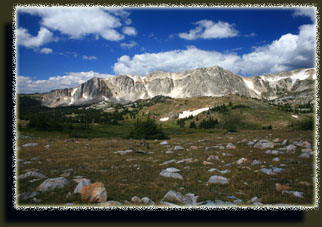

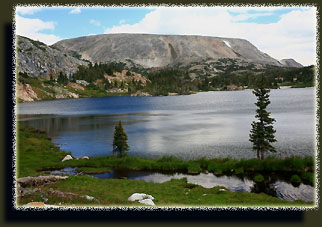
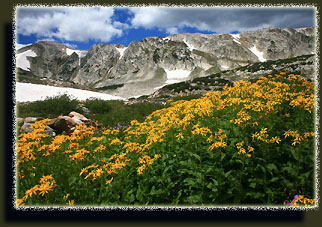
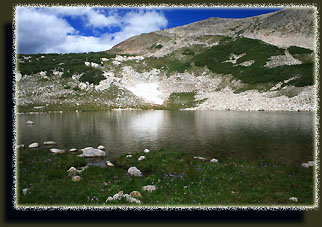
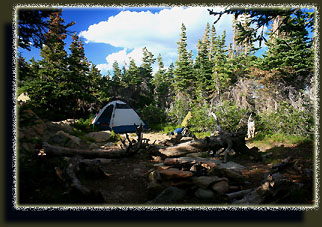
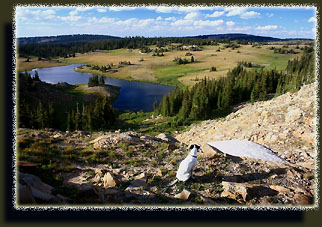
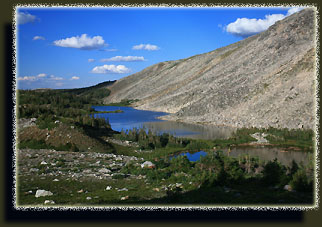
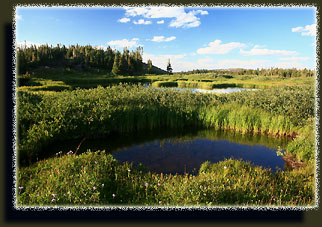
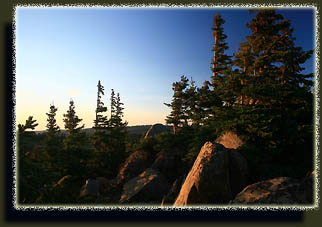
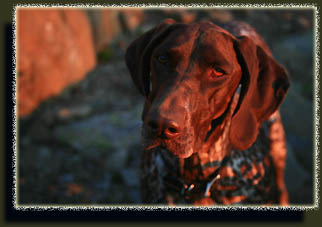
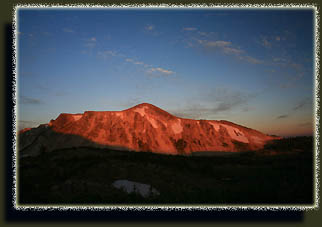
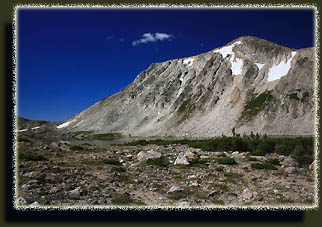
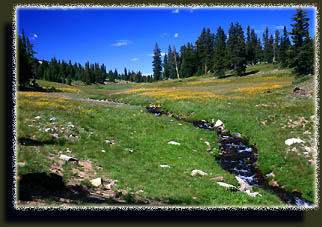
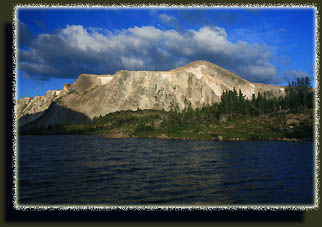
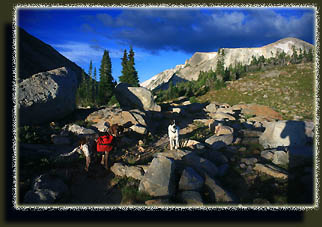
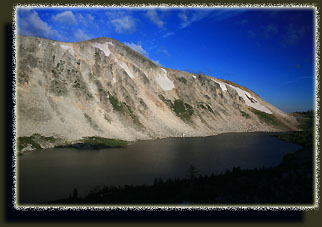
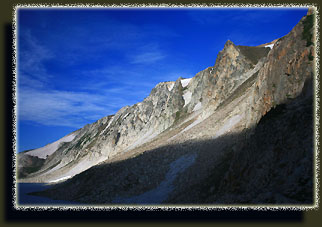
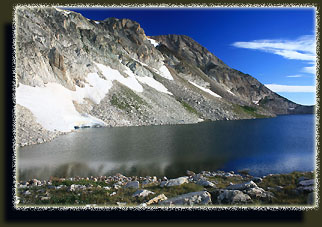
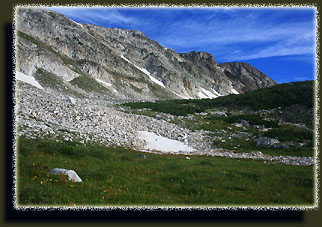
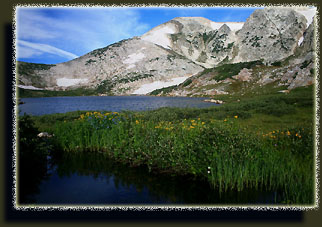
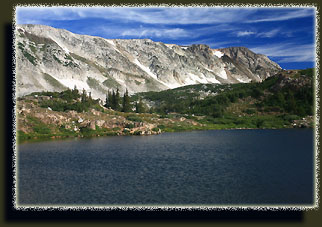 |























